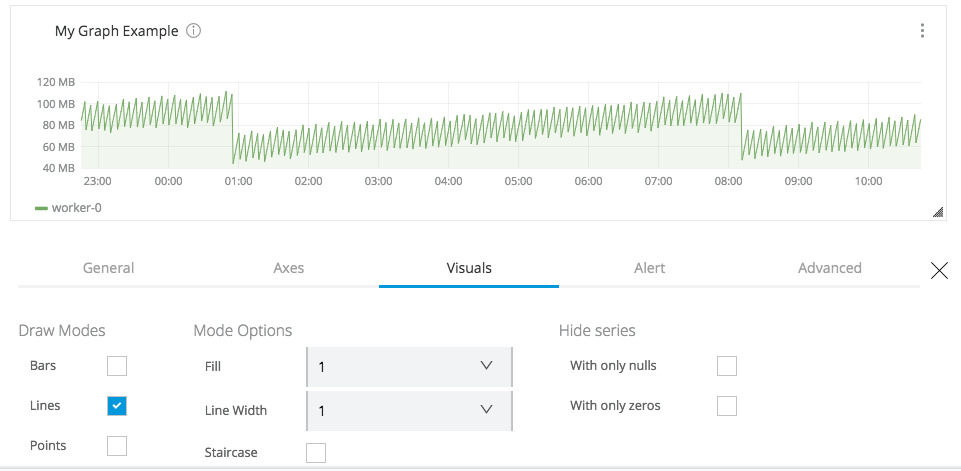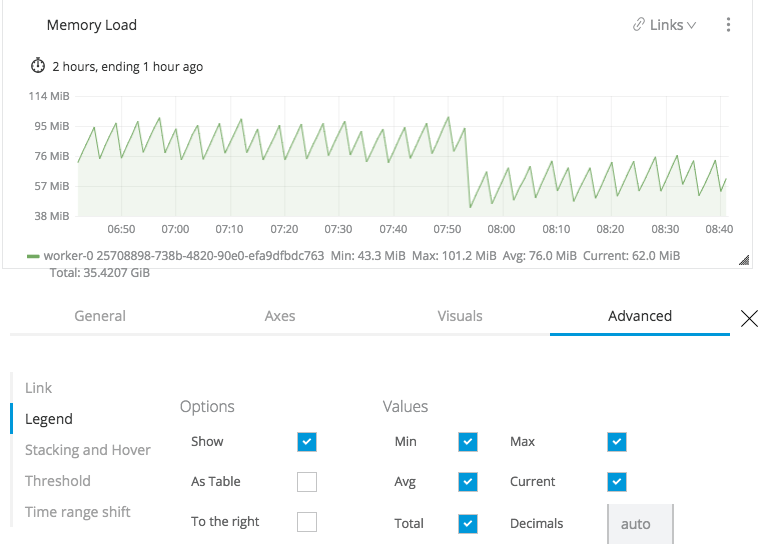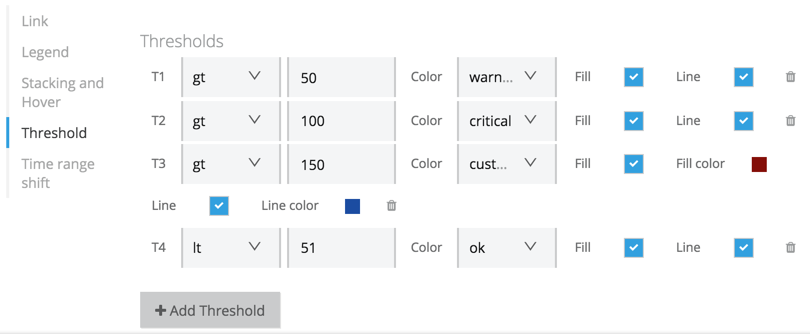From the drop-down menu, select the type of panel to display for the resource — Application Panel, API Panel, or API Analytics Panel (deprecated).
Configuring Graphs in a Custom Dashboard
In Anypoint Monitoring, you can configure one or more sets of time-series data in a graph. The graph measures the changes to time-series data over time. A graph in a custom dashboard can display a metric for a resource in a given environment. For example, to configure a graph, you might select a response time or heap usage as the metric to graph for a Mule app in your Design or Sandbox environment.
Advanced configuration options allow for more fine-tuned data sets. You can also customize the X and Y axes, the look of the graph, legends, the behavior when you hover over a data point, and more.
To open a configuration page for a graph, see Configure Custom Dashboards.
General Settings for Basic and Advanced Data Queries
General tab settings include basic and advanced queries (or modes) for configuring time-series data. Both configurations share fields for the title and a short description.
| Basic and Advanced Mode Settings | |
|---|---|
Title |
Title to display in the UI. Defaults to Panel Title. |
Description |
Short description to display in the UI when users hover over the information ( |
Other settings are specific to the setting mode (basic or advanced).
Basic Mode
In the General configuration tab, a basic query selects a single metric for a resource (a deployed application or API) in a given environment.
| Basic Mode Settings | |
|---|---|
Panel Type |
|
Metric |
The drop-down menu includes these types of metrics:
For a list of basic metrics, see Basic Mode Metrics |
Environment |
The environment where your application or API is deployed. |
Resource |
A deployed application. This option is available only if you selected |
API |
A deployed API. This option is available only if you selected |
Version / Instance |
The Mule version or instance on which your API is deployed. This option is available only if you selected |
After you complete your configuration, click Save Changes.
To exit the configuration and return to the dashboard, click the X.
| When you create an application panel using a JVM metric, the query that supports the panel uses only the worker-id for the app. When you modify the panel at a later time, the resource fields are populated with the query content. Because some apps share a worker-id, the resource that appears in the selector might appear to be a different resource from the resource you selected originally. However, all resources share the same worker, so the query has the correct information despite the selector displaying a different resource name. |
Advanced Mode
In the General configuration tab, advanced settings support one or more fine-tuned queries for your chart.
| If you switch back to the basic configuration, some of the advanced configuration queries are removed. |

| Advanced Mode Settings for Applications | |
|---|---|
From |
Lists JVM and Mule app properties (such as This field provides matching suggestions when you type in a character. For example, For a list of advanced metrics, see Advanced Mode Metrics |
Where |
Supports conditional logic for filtering the From data source you selected.
Grouping |
Select |
Add one or more |
Group By |
For grouping the data by a selected time interval (such as Valid values and arguments:
|
Alias By |
You can create a label for your metric using a literal string (such as |
| Advanced Mode Settings for APIs | |
|---|---|
From |
For a list of advanced metrics, see Advanced Mode Metrics |
Where |
Provides conditional logic for filtering the From data source you selected. You can select one or more filter tags (such as |
Select |
For creating a function that selects a field (such as |
Group by |
For grouping the data by a selected time interval (such as |
Alias by |
You can create a label for your metric using a literal string (such as To use your tag as an alias, the tag must be used to |
After you complete your configuration, click Save Changes.
To exit the configuration and return to the dashboard, click X.
Axes (X-Axis and Y-Axis Settings)
Configure the x-axis and y-axis of your graph in the Axes tab.
Y-Axis Settings
Set a vertical y-axis for the left (Left Y) or right (Right Y) side of your graph.
| Y-Axis Settings | |
|---|---|
Show |
If unchecked, hides the y-axis from the graph. |
Unit |
The unit of measurement to use for values on the y-axis. Values include |
Scale |
Valid values for a linear or logarithmic (log) scale for coordinates on the y-axis:
|
Y-Min |
The minimum value for a y-coordinate. Defaults to |
Y-Max |
The maximum value for a y-coordinate. Defaults to |
Decimals |
Override for the automatic decimal precision on y-coordinates, for example, where |
Label |
A string used to label the Y axis. Defaults to |
X-Axis Settings
| X-Axis Settings | |
|---|---|
Show |
If unchecked, hides the x-axis from the graph. |
Mode |
Valid values:
|
Value |
Visible only if Series is selected. |
Buckets |
Visible only if Histogram is selected. Divides the range of values for a given metric into the specified number of intervals so that the histogram can display the count or frequency of data points that fall into that interval. |
After you complete your configuration, you can click Save Changes. To exit the configuration and return to the dashboard, simply click the X.
Visuals (Bar, Line, Data Point Settings)
You can configure the style and look of graph to use. Bar, line, and point graphs are supported.

| Visual Configuration Options | |
|---|---|
Draw Modes |
You can check one or more of these modes:
|
Mode Options |
Only available when the selected Draw Modes are Lines or Points.
|
Hide Series |
|
After you complete your configuration, you can click Save Changes. To exit the configuration and return to the dashboard, simply click the X.
Alerts (Configuration, Notifications, History)
|
In the Alerts tab, set up alerts that trigger when JVM memory utilization is too high.
Create an Alert for a Chart in a Custom Dashboard
-
Navigate to the configuration screen for a graph in a custom dashboard. For guidance, see Configuring Custom Dashboards.
-
Provide a general configuration for the graph that (at minimum) defines the metric, environment, and resource for which you want to set the alert.
For guidance, see General Settings.
-
Navigate to the Alert configuration tab for the graph.
-
Ensure that Advanced Mode is disabled.
Alerts aren’t available for charts with advanced mode configurations.
-
Click Add Alert.
-
Use Alert Config to configure the alert. See Alert Config.
-
Configure email notifications when an alert is triggered. See Notifications.
-
Click Save Changes.
-
Click
Xto exit the configuration and return to the dashboard.
Note that you can also view state history and delete alerts.
Configure an Alert for a Chart in a Custom Dashboard
In the Alert Config section, configure the condition under which an alert is triggered.
| Settings for Alerts in Custom Dashboards | |
|---|---|
Name |
A title for your alert |
Severity level |
The severity level of your alert. |
|
WHEN: For triggering an alert when the metric being measured is above a specified level |
Available severity levels:
- Info
-
May be assigned to alerts that do not require immediate attention when triggered. This severity indicates the metric should be passively monitored.
- Warning
-
May be assigned to alerts that require prompt attention when triggered. This severity indicates an alert should be closely monitored.
- Critical
-
May be assigned to alerts that require immediate attention when triggered. This severity indicates an alert should receive an immediate response.
Notifications
Configure an email notification when an alert is triggered.
| Notification Settings for Alerts | |
|---|---|
|
Email address for each recipient of the alert notification. If you add or change the email address of an alert recipient, they don’t receive an email until the alert is triggered. |
|
Message to send to the recipient. |
Advanced (Legends, Thresholds, Stacking, Hovering, Time Shift Settings)
Add and configure legends, thresholds, and other features for your graph.
Legends (Advanced Setting)
In the Advanced configuration tab, configure legends for your graphs.

| Legend Options | |
|---|---|
Show |
Unchecking hides the legend. Checked by default. |
As Table |
Check to display the selected legend Values (such as |
To the Right |
Check to display the legend on the right side. Unchecked by default. |
Width |
Available when To the Right is checked. Sets the minimum width (in pixels) for the legend. Leave it blank to allow for automatic width selection. |
You can also display the following values in a legend:
| Legend Values | |
|---|---|
Min |
Minimum of all values returned from the query |
Max |
Maximum of all values returned from the query |
Avg |
Average of all values returned from the query |
Current |
Last value returned from the query |
Total |
Sum of all values returned from metric query |
Decimals |
Overrides automatic decimal precision used in legends and tooltips |
After you complete your configuration, click Save Changes.
To exit the configuration and return to the dashboard, click the X.
Stacking and Hover (Advanced Setting)
In the Advanced configuration tab, you can configure a hover tooltip to display information about a data point in a graph when you hover over the value.

| Hover Tooltip Settings | |
|---|---|
Mode |
To display one or all series in the tooltip. |
Sort Order |
Displays data in no order (None), Decreasing, or Increasing order. Defaults to None. |
Stacked Value |
Available when Stack is checked. Controls the display of values in the tooltip. Valid values are:
|
Stacking and Null functionality displays multiple series as a group within a stack. You can also specify how to deal with null values.
| Stacking and Null Settings | |
|---|---|
Stack |
When checked, stacks each series, one on top of another, instead of overlaying them. |
Percent |
Available when Stack is checked. Displays each series of stacked values as a percentage. |
Null Value |
Determines how to display null values: Connected, Null, Null As Zero. |
Threshold (Advanced Setting)
In the Advanced configuration tab, you can set one or more thresholds, such as a line or section to a graph, to indicate whether the data crosses a limit that you specify.
| Thresholds are not available when an alert is in place on the graph. To re-enable thresholds for a chart, you must delete the alert. |

| Threshold Settings | |
|---|---|
|
Indicates whether the limit applies to data that is greater than ( |
Threshold value |
A numeric value for the threshold. |
Threshold type |
Identifier for the threshold (Custom, Critical, Warning, or OK). |
Fill |
Adds a filler color to the graph that corresponds to the specified threshold setting. |
Line |
Adds a line to the graph that corresponds to the specified threshold setting. |
Fill Color |
Similar to Fill settings, but for custom thresholds only. |
Line Color |
Similar to Line settings, but for custom thresholds only. |
Time Range Shift (Advanced Setting)
In the Advanced configuration tab, you can set overrides any time intervals or ranges that end users select for the custom dashboard. Such selections are global and apply to all charts in the dashboard. Overrides are useful when the selection does not make sense for a particular graph.
Time ranges are calculated backwards from the present time. For example, you might set the time range so you can view the last 2 hours of data in a graph. You can also shift the time range to calculate backwards from an earlier point in time, for example, from 1 hour ago instead of from the present time.
| Time Range Shift Settings | |
|---|---|
Override Relative Time |
The amount of time to show in the x-axis of the graph (for example, |
Add Time Shift |
Amount of time before now (the current time) to end (or shift back in time) the duration set by Override Relative Time. For example, if the time right now is 10:00, and you shift the time to |
Hide Time Override Info |
Checkbox for hiding the description of any Override Relative Time and Time Shift settings from the graph. |
After you complete your configuration, you can click Save Changes. To exit the configuration and return to the dashboard, simply click the X.



